Inamori Library
2F Technology and Management: Exhibition Details
- Shofu Industrial
- Kyocera Corporation
- KDDI Corporation
- Japan Airlines Co., Ltd
- Amoeba Management/Kyocera Accounting Principles
Shofu Industrial
In 1955, after graduating from Kagoshima University, Inamori accepted a job with a company called Shofu Industrial. In the past, Shofu Industrial had made a name for itself as one of Japan's leading manufacturers of power system insulators. However, its business performance declined after World War II. By the time Inamori joined, the company had been driven into severe business straits and was teetering on the brink of bankruptcy. Amid these circumstances, Inamori was assigned to the research section of Shofu Industrial's manufacturing division, where he became involved in research and development of specialized ceramics, now known as fine ceramics.
Successfully synthesized forsterite for the first time in Japan
Working for Shofu Industrial, Inamori began his career as an engineer focused on fine ceramics. In the first year, his research produced a significant achievement when he became the first person in Japan to synthesize forsterite successfully. Forsterite has superior, high-frequency insulation properties, and was used in televisions and other equipment.
The television era was just dawning, and Inamori developed a forsterite-based television component known as the U-shaped Kelcima. It was an essential component of cathode-ray tubes used in televisions of the day. Later, the forsterite-based U-shaped Kelcima became a core product that supported Kyocera's growth in the company's early years. Forsterite became a widely used material in television components, resistor cores and other products of the time, contributing to the spread of household products, including televisions, radios and cameras.

Developed unique electric-tunnel kiln
As production of the U-shaped Kelcima increased, Inamori sought to improve the efficiency of mass production. Consequently, he designed a continuous electric tunnel kiln to replace the conventional batch(1) electric kiln that was previously used.
With the electric tunnel kiln, products are placed on base plates and moved through the tunnel using a pusher. Previously, products were fired in batches and transferred through three different kilns for the calcination, sintering and residual heating processes. The new method was an epic innovation at the time, enabling a dramatic improvement in efficiency by consolidating all three processes into one kiln.
*1 Each process was completed more or less separately in different kilns ― in the case of firing ceramics, the processes include calcination, sintering and residual heating. For each process, the materials are gathered together and loaded into a different kiln.
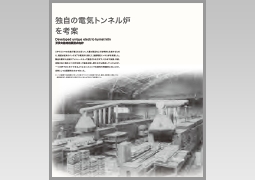
Kyocera Corporation
Inamori founded Kyocera Corporation ― then named Kyoto Ceramic Company ― and grew it into one of the world's leading manufacturers of fine ceramics. Today, in addition to various fine ceramic components and electronic device businesses, the Kyocera Group has developed into a diversified corporate group that includes communications equipment, information equipment and solar energy businesses in countries all over the world. In the 60-plus years since the company was founded, Kyocera has consistently maintained a high profit ratio and has never incurred an annual loss -- which is a rare phenomenon in corporate history.
1959~1963
Founded Kyocera with a lofty goal
In April 1959, alongside seven like-minded colleagues, Inamori established Kyoto Ceramic and was appointed to its Board of Directors and General Manager for Engineering. The company began operations in a small, rented corner of the warehouse of Miyaki Electric Manufacturing Company, a Kyoto-based maker of power switchboards. Inamori understood the necessity of setting high goals in order for the business to develop. Therefore, whenever the opportunity arose, he spoke to employees about his grand vision for the future: First, they would become the No. 1 company in Kyoto; next, No. 1 in Japan; and ultimately, the greatest company in the world. This goal encouraged his employees. It stirred their passion toward work and became the driving force behind Kyocera's growth.
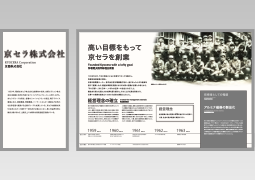
Created the management rationale
The original purpose of founding Kyocera was "to present Kazuo Inamori's technology to the world." However, early in the company's third year, a group of new employees who were hired in the previous year decided to engage in collective bargaining. They demanded wage guarantees for the future. After three days and nights of talks, the employees finally reached an understanding with Inamori. They withdrew their demands and remained with the company.
As a result of this confrontation, Inamori realized that business management entailed "safeguarding the livelihood of employees and their families, not just today, but also throughout the future." The lesson Inamori learned from this experience was that, in management, the manager must focus all of his capabilities on doing everything possible for the wellbeing of employees. The company must have a just cause, and be run by a leader who has relinquished self-interest.
Accordingly, the opening section of the Management Rationale became, "To provide opportunities for the material and intellectual growth of all employees." Furthermore, to meet the company's responsibilities as a member of society, he added, "Contribute to the advancement of society and humankind." The two phrases were combined to create the Kyocera Management Rationale.
The Management Rationale
To provide opportunities for the material and intellectual growth of all our employees, and through our joint efforts, contribute to the advancement of society and humankind.
Company Milestones
| 1959 | Kyoto Ceramic Company was founded in the Nishinokyo-Haramachi district of Nakagyo Ward, Kyoto City |
|---|---|
| 1960 | All employees became shareholders, with increased capital allocated to employees in the form of bonus stock |
| 1961 | Established the Management Rationale following collective bargaining by high school-graduate employees |
| 1962 | First overseas business trip, to the US |
| 1963 | Established the Shiga Gamo Plant |
Society Highlights
| 1959 | The marriage of Crown Prince Akihito and Michiko Shoda |
|---|---|
| 1960 | Summer Olympics held in Rome |
| 1961 | Soviet Union successfully conducted the world's first manned space flight |
| 1963 | Kurobe Dam No. 4 Hydropower Plant completed |
Inamori the Engineer
Commercialization of alumina ceramics
Kyocera's first high-purity alumina (a common material for fine ceramics) ceramic products were used in the cathode-ray tubes of picture-tube televisions. Compared with forsterite ceramics, high-purity alumina ceramics are fired at much higher temperatures. Work therefore started with the construction of a suitable kiln.
Inamori overcame various production difficulties, such as developing a new molding technique for forming extremely thin components, and succeeded in the commercialization and mass production of high-purity alumina ceramics. The production technology devised for alumina ceramics played a role in supporting the further development of Kyocera.
1964~1968
Created Amoeba Management
When the Shiga Gamo Plant was completed in 1963, Kyocera became a two-plant company, with its headquarters plant in Nishinokyo-Haramachi.
In 1965, Inamori devised the Hourly Efficiency system, which functioned as a management accounting indicator. Its purpose was to provide timely awareness of the state of the business as the company grew in scale. When "Maximizing Revenues and Minimizing Expenses," the difference between revenues and expenses -- called Added Value -- is also maximized. Hourly Efficiency depicts this management principle in the form of a profit table. The Added Value created through work is divided by total working hours, resulting in Added Value per Hour. He named this last figure Hourly Efficiency.
Additionally, Inamori created a unique "small-unit profit center" system, which he named Amoeba Management. This mechanism was designed to heighten employee awareness of participation in management and to consolidate individual strengths. Under Amoeba Management, an organization is divided into independent profit units, called Amoebas. Employees appointed as Amoeba leaders are entrusted with general managerial responsibilities such as management plans, performance management and labor management. They can acquire managerial thinking and skills through managing these units. Moreover, in this system, the operational results of each Amoeba are disclosed to all employees in that Amoeba unit, thus enabling management participation by all employees.
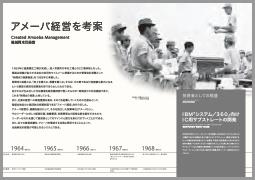
Company Milestones
| 1964 | Established an international trade department |
|---|---|
| 1965 | Introduced the Hourly Efficiency system |
| 1966 | Inamori appointed as president |
| 1967 | First edition of the Kyocera Philosophy series, summarizing Inamori's management philosophy and attitude toward management, issued to employees |
| 1968 | Kyocera received the first Medium and Small Business Research Institute Award |
Society Highlights
| 1964 | Summer Olympics held in Tokyo |
|---|---|
| 1965 | Meishin Expressway fully opened |
| 1966 | Population of Japan exceeded 100 million people |
| 1967 | European Communities (EC) and Association of Southeast Asian Nations (ASEAN) came into being |
| 1968 | Ogasawara Islands were returned to Japan, 23 years after the war |
Inamori the Engineer
Developed hybrid IC substrates for IBM System/360
Kyocera alumina substrates were used in integrated circuits (ICs) at the heart of the IBM System/360, which took the world by storm as the first general-use computer. The ceramic substrates represented the highest level of quality possible at the time in terms of material technology, processed dimensional precision, flatness, surface smoothness and other aspects. Kyocera alumina substrates were thus established as the industry standard for substrates used in Ics. That's how Kyocera gained a reputation as a manufacturer of fine ceramics among electronic product manufacturers both in Japan and overseas.
1969~1973
Developed world's first multilayer ceramic packages for ICs
In the early 1960s, alongside the rise of the US semiconductor industry, Inamori applied fine ceramics technology to develop the first multilayer ceramic packages. These packages are essential for protecting semiconductors. To succeed in commercializing these packages, he went above and beyond the conventional wisdom of ceramics technology at the time to develop methodologies, including tape-molding, simultaneous firing and other groundbreaking methods.
Convinced of the tremendous potential of this new product, Inamori decided to undertake bold capital investment. He overcame numerous problems along the way and succeeded in leading the world in mass production.
After that, Kyocera continued to achieve rapid growth while adhering tightly to its Customer-First Principle. Kyocera thus made significant contributions to the global semiconductor industry's development.
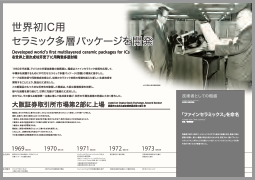
Listed on Osaka Stock Exchange, Second Section
When it was time to list Kyocera shares on the stock exchange, Inamori carefully considered which method would be most appropriate.
Typically, there are three ways a corporation can list its shares:
1. Existing shareholders could release the shares they hold into the market. That would give the original shareholders substantial gains.
2. The company could issue new shares for release into the market. The funds obtained from selling the new shares would go to the company.
3. A combination of the two methods above.
Inamori chose the second method, opting to issue new shares for listing. Consequently, all funds from the sale of newly listed shares went into Kyocera, building a strong financial foundation for dynamic business development in the future.
Company Milestones
| 1969 | Established the Kagoshima Sendai Plant and began mass production of multilayer ceramic packages for integrated circuits (ICs) |
|---|---|
| 1971 |
Began overseas production for the first time, in San Diego, California, US. |
| 1972 | Established the Kagoshima Kokubu Plant |
| 1973 | All employees were given a trip to Hong Kong, to commemorate achieving monthly sales of 900 million yen |
Society Highlights
| 1969 | America's Apollo 11 landed on the surface of the Moon, a first in human history |
|---|---|
| 1970 | "Expo '70" World Exposition held in Osaka |
| 1971 | The Japanese yen shifted to a floating exchange rate system due to the "Nixon shock" |
| 1972 | Administrative rights to Okinawa restored to Japan; Okinawa Prefecture created |
| 1973 | The first "oil shock" |
Inamori the Engineer
Coined the term "fine ceramics" ― 1973
In contrast to ceramic components and insulators, today, the term "fine ceramics" is commonly used for ceramic products featuring precisely controlled chemical compositions, structures, dimensions and manufacturing processes that offer new functions and characteristics. In fact, the term fine ceramics was first coined by Inamori.
1974~1978
Tenaciously safeguarded employment despite oil shock, and maintained high productivity
During the recession following the first "oil shock" in 1973, Kyocera's product orders fell dramatically, by 90%. Facing a recession and having vowed to safeguard employment by all available means, Inamori set about implementing all conceivable countermeasures. These included maintaining productivity, diverting all available employees to sales activities, and developing new products.
Even so, demand remained stagnant. Realizing that this was the greatest crisis since the company began, Inamori made some painful decisions: He reduced wages for management-level employees and proposed a freeze on wage increases to the labor union. Employees understood that the company was in a crisis. They accepted a temporary freeze on wage increases and united in applying earnest efforts toward restoring business performance.
Two factors brought about this cooperative employee attitude:
1) Employees fully understood that Inamori had always devoted himself to achieving the material and intellectual growth of employees since the company was founded; and
2) Due to the practice of transparent management, employees were well aware of the true state of the company's business.
Inamori's decisions proved beneficial: When the economy finally began to recover, Kyocera was well ahead of other companies in recovering its business performance. Inamori repaid the efforts of employees the following year with a substantial wage increase that included the pay increase not given while wages were frozen, plus a one-time bonus. The major trial of the first oil shock further strengthened Kyocera's corporate structure and led to development that exceeded pre-oil shock levels.
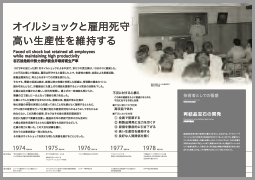
In readiness for recession
Based on this experience, Inamori summarized his preventive measures and countermeasures for recession.
- Preventive measure to prepare for recession
- Maintain a consistently high profit level
- Countermeasures in time of recession
- Every employee must be a salesperson
- Put all your energy into developing new products
- Minimize production costs
- Maintain high productivity
- Establish mutual trust
Company Milestones
| 1974 | Received the 1974 Commendation by Japan's Director-General of the Science and Technology Agency for developing ceramic lamination technology for electronic circuits |
|---|---|
| 1975 |
Kyocera share price reached the highest value among shares in Japan |
| 1976 | Issued American Depository Receipts |
| 1977 | Established the Applied Technology Research Center to develop ceramic engines |
| 1978 | Japan's Science and Technology Agency selected monocrystalline sapphire ceramic biomaterial for The 38th Notable Alluring Inventions |
Society Highlights
| 1974 | President Ford visited Japan for the first time as US president |
|---|---|
| 1975 | The Rambouillet Summit―the first summit of advanced nations, now called the G7―was held at Château de Rambouillet |
| 1976 | Lockheed Scandal occurred |
| 1977 | Japan professional baseballer Sadaharu Oh achieved a world record with 756 career home runs |
| 1978 | Treaty of Peace and Friendship between Japan and the People's Republic of China signed |
Inamori the Engineer
Developed recrystallized gemstones ― 1975
During a period of high economic growth, Japan attained economic prosperity. People once again enjoyed the means to pay attention to fashion and accessories. Demand for rings, necklaces and other jewelry was particularly strong. However, as the availability of quality natural stones including emeralds and rubies fell worldwide, prices remained high. Intending to help people get what they wanted, Inamori found a way to create recrystallized gemstones with precisely the same composition and structure as natural stones. He discovered this method by applying fine ceramics technology.
1979~1983
Successively acquired Cybernet Electronics Corporation and Yashica Co., Ltd.
In 1979, Inamori purchased Cybernet Electronics Corporation, a communications equipment manufacturer. Four years later, he purchased a camera manufacturer, Yashica Company. Both acquisitions were the result of requests from the companies for assistance.
Although Inamori had previously pushed forward with diversification strategies, entering the electronic equipment and camera businesses was considered too risky. They were not extensions of ceramic technology; they instead entailed expansion into completely different business areas. However, the managers of the acquired companies had made a sincere appeal to help their companies' employees. Furthermore, Inamori was touched by the employees' enthusiastic and resolute approach toward work, despite uncertainty about the future. Inamori therefore made a benevolent decision to purchase the companies.
After the acquisitions, despite badgering from extremist labor unions, Inamori's mind was set on saving the employees of both companies, and he succeeded in resurrecting the businesses. Later, personnel from both companies became a driving strength behind the Kyocera Group's development. They became the core of Kyocera's communication equipment business, for example, and contributed substantially to establishing Daini-Denden (DDI), the communications company.
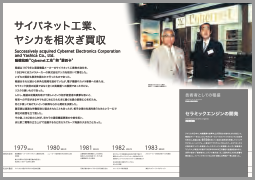
Company Milestones
| 1979 | Acquired Cybernet Electronics Corp., an electronic communications equipment manufacturer |
|---|---|
| 1979 | Employees were given a trip to Singapore to commemorate the company's 20th anniversary and achieving 5 billion yen in monthly production |
| 1980 | Listed on the New York Stock Exchange |
| 1981 | Began selling the portable solar cell SB-II, a stand-alone, solar cell power source commercialized for consumer use |
| 1982 |
NHK broadcast a test run of a vehicle with the world's first ceramic engine, jointly developed by Kyocera and Isuzu Motors ― setting off a fine ceramics boom |
| 1983 | Acquired Yashica Company, a camera manufacturer |
Society Highlights
| 1979 | The US and China restored diplomatic relations after 30 years |
|---|---|
| 1981 | The Japanese yen continued to strengthen, breaking the USD=200 yen barrier for the first time |
| 1982 | The Falklands War erupted |
| 1983 | Tokyo Disneyland opened |
Inamori the Engineer
Developed ceramic engines
When research in the US and Japan started to focus on improving the efficiency of internal combustion engines, Inamori began considering how to apply fine ceramics technology to diesel engines and gas turbines.
Kyocera devised an original molding technique using silicon nitride, a material that tolerates extremely high temperatures, and designed an uncooled all-ceramic engine. All engine parts, including the cylinders, pistons and head-plates, were made of ceramics. An Isuzu Motors Gemini was retrofitted with the engine, and a 1982 New Year's television program broadcast by NHK showed footage of the car in action. The sight of a car running on a kiln-fired engine caused a sensation in both Japan and abroad, leading to a surge in interest and acclaim for fine ceramics.
1984~1988
Awarded company stock to employees; everyone became shareholders
Ever since the company was founded, Inamori encouraged employees to hold Kyocera shares, to stimulate their awareness and participation in company management. Following its stock exchange listing, Kyocera established an internal investment association for the company's stock. However, buying Kyocera shares was prohibitive due to the high stock price. To celebrate Kyocera's 25th anniversary on April 1, 1984, Inamori invited employees on a four-day trip to Tokyo to reward their hard work over the past quarter of a century. A Foundation Anniversary Ceremony took place during the trip. During a party after the ceremony, Inamori expressed his sincere appreciation to employees and presented every employee with Kyocera shares taken from his personal holdings.
In addition to showing appreciation for their long-term efforts, by making all employees shareholders in Kyocera, Inamori hoped to raise their awareness of participation in management as employees engaged in their work.
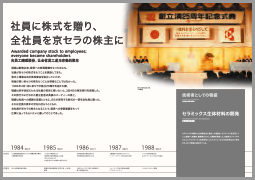
Company Milestones
| 1984 | Received the Medal with Purple Ribbon awarded by the Cabinet Office for developing layer-based ceramic technology used in large-scale integrated circuits |
|---|---|
| 1985 | Presented exhibits at The International Science Technology Exposition held in Tsukuba City. Kyocera's kincera material, a compound of metal and ceramics, was used to make the official Exposition commemorative medals |
| 1986 | Inamori gave up his dual positions of president and chairman of Kyocera and became full-time chairman |
| 1987 | Japan Solar Energy Corp., a producer of solar cells, merged with Kyocera |
| 1988 | Established Kyocera Europe GmbH in Germany as Kyocera's integrated European headquarters company |
Society Highlights
| 1984 | NHK began broadcasting by satellite |
|---|---|
| 1985 | The International Science Technology Exposition (Science Expo / Tsukuba Expo) opened |
| 1986 | Chernobyl nuclear power plant reactor exploded in the Soviet Union |
| 1987 | Sharp stock sell-off at the New York Stock Exchange (Black Monday) |
| 1988 | Summer Olympics held in Seoul |
Inamori the Engineer
Developed ceramic biomaterials
Focusing on the excellent biocompatibility of ceramics, Inamori applied ceramic technology to develop ceramic dental implants along with artificial hip and knee joints. The widespread use of ceramic biomaterials based on monocrystalline sapphire and zirconia ceramic has improved the quality of life for thousands of people.
1989~1993
Merged with US company AVX Corporation via international stock swap
In 1990, aiming to strengthen the electronic components business on a global scale, Inamori brought AVX Corp. (currently known as KYOCERA AVX Components Corporation), a major US electronic components manufacturer, into the Kyocera Group. The acquisition was achieved through a method unprecedented in Japan ― an exchange of shares with a foreign company. Until then, it was thought that domestic commercial law effectively prevented stock swaps with foreign companies.
However, after carefully examining the law in detail, Inamori determined it was entirely possible. He achieved the stock swap after tenacious negotiations with the relevant administrative authorities.Inamori refused to accept so-called common sense on blind faith. By examining the essence of the law, he was able to achieve what was previously regarded as impossible.
Furthermore, though he left the management of AVX Corp. to that company's existing management team, Inamori worked hard to build a shared and thorough understanding of Kyocera's Management Rationale and Philosophy with the company's employees, based on the idea that we must "Do what is right as a human being." In a short time ― less than five years after the acquisition ― AVX was successfully relisted on the New York Stock Exchange. Since then, AVX has continued to achieve steady growth and development.
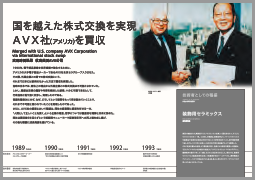
Company Milestones
| 1989 | Acquired the Elco Group, a US maker of connectors |
|---|---|
| 1990 | Held a Kyocera Technology Exhibition in Tokyo and Osaka as a 30th anniversary commemorative event |
| 1991 | Adopted the Kyocera Environmental Charter |
| 1993 | Began selling the industry's first solar power generation system for residential use in Japan |
Society Highlights
| 1989 | Passing of the Emperor of the Showa era; the new era was named Heisei |
|---|---|
| 1990 | The Berlin Wall came down; East Germany merged with West Germany, and a reunified Germany was born |
| 1991 | The Gulf War broke out in Iraq |
| 1992 | A five-day school week system began in Japan |
| 1993 |
The European Union, the world's largest economic bloc, was created |
Inamori the Engineer
Decorative ceramics
Alumina ceramics, which are fired at high temperatures, have elegant translucence. Inamori recognized the beauty of ceramics and had been researching the possibilities of decorative and artistic applications of fine ceramics since the late 1950s. After repeated trial and error, in 1974, he developed a multi-crystalline alumina with a beautiful red and blue translucence.
Transparency increased as a result of research advancements, and Inamori applied the vividly colored materials he developed to creating artwork. These included the Inamori Collection ― Meissen Design, featuring illustrations by artists with the Meissen Porcelain Manufactory in Germany, and the Gyokuji brand featuring Satsuma ceramic ware designs.
Today, decorative colored ceramics are used in high-end watch cases and bezels, push keys for mobile communication devices, camera parts and other products, in colors including gold, silver, black, white and brown.
1994~1998
Successfully restructured Mita Industrial Co., Ltd.
Mita Industrial Company., a mid-sized copier manufacturer, collapsed in 1998. In response to a request for help, Inamori led the restructuring of the company. Mita had slipped into an operating crisis due to lax business practices and failure to keep up with digitalization. The company's president at the time hoped to keep the company in existence for the sake of its employees and to avoid causing problems for dealers and end-users of Mita Industrial products. He applied for corporate bankruptcy reorganization and asked Inamori for help.
Inamori concurred with his thinking and accepted the request out of a genuine desire to help the company's employees. Mita received full support from Kyocera, the company name was changed to Kyocera Mita Co., Ltd., and business recovered relatively quickly. The original reorganization plan took seven fewer years than anticipated and was completed at the end of March 2002.
Later, the business was integrated into Kyocera's printer business. Today, the combined business is achieving sound growth as Kyocera Document Solutions Incorporated.
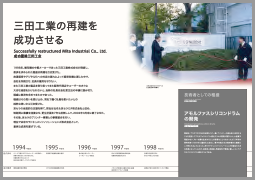
Company Milestones
| 1994 | Took the central role among Kyoto's business community in establishing an incorporated soccer club, Kyoto Purple Sanga. The goal was to cultivate a professional soccer team that could compete in the Japan League and to support the revitalization of Kyoto. |
|---|---|
| 1995 | Inamori appointed chairman of the Kyoto Chamber of Commerce and Industry |
| 1996 | Established Kyocera Solar Corporation |
| 1997 | Inamori resigned as chairman of Kyocera and became chairman emeritus |
| 1998 | New Kyocera headquarters building completed in Takeda district of Fushimi Ward, Kyoto City |
Society Highlights
| 1994 | Kansai International Airport opened |
|---|---|
| 1995 | World Trade Organization (WTO) established |
| 1997 | The UK returned administrative rights over Hong Kong to China. |
| 1997 | Tokyo Bay Aqua-Line Expressway (Trans-Tokyo Bay Highway) opened |
| 1998 | The 18th Winter Olympics held in Nagano Prefecture |
Inamori the Engineer
Developed amorphous silicon photoreceptor drums
Intending to apply the plasma-enhanced chemical vapor deposition (PECVD) method of technology to copiers and printer photoreceptors, Inamori began developing an amorphous silicon photoreceptor drum. Creating a perfectly uniform layer of amorphous silicon over such a large area was not easy. After five years of development, mass production began in 1984. The amorphous silicon drum came into use as the heart of electrographic-type copiers. One unique feature of Kyocera Document Solutions products is the amorphous silicon photoreceptor drum, which is recognized for its long life, high sensitivity, high heat tolerance and eco-friendliness.
1999~2008
Successfully commercialized solar energy business
In 1975, while repercussions of the oil shock were still being felt, Inamori took a step toward developing solar cells. He wanted to apply Kyocera technology to help solve the global energy crisis stemming from our planet's depleting oil supply.
However, after the oil shock, oil demand and supply problems eased, and the business opportunity for developing alternative energy sources quickly diminished. The solar cell market thus entered a long period of stagnation. As R&D budgets in various countries were curtailed, company after company withdrew from the business and ceased research. Despite such difficult times, Inamori's belief in the potential for solar power to contribute to the world did not waver. He continued his commitment to solar cell research through developing cells with greater power efficiency and other improvements.
This struggle lasted for about a quarter of a century. Then, in the late 1990s, interest in environmental issues began to rise, and governments started introducing policies aimed at promoting renewable energy use. The business environment started to improve, and Kyocera soon established its position in the solar cell market as a global manufacturer.
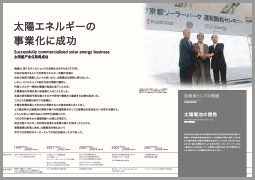
Company Milestones
| 2000 |
Kyocera Mita Corp. was established (now Kyocera Document Solutions, Inc.) |
|---|---|
| 2001 | Acquired Tycom Corp., a US-based specialized manufacturer of printed circuit board drills, through Kyocera International, Inc. |
| 2002 | Acquired Toshiba Chemical Corp., changing the name to Kyocera Chemical Corp. |
| 2003 | Established Kyocera (Tianjin) Sales & Trading Corporation, now Kyocera (China) Sales & Trading Corporation |
| 2004 | Established Japan Medical Materials Corp. |
| 2005 | Established the Inamori Academy of Management and Technology (now Inamori Academy) at Kagoshima University |
| 2006 | Established Kyocera Korea Co., Ltd. |
| 2008 | Took over the mobile phone business of Sanyo Electric Co., Ltd. |
Society Highlights
| 1999 | The European Union's single currency, the euro, was introduced |
|---|---|
| 2000 | In the Sydney Summer Olympics Women's Marathon, Naoko Takahashi became the first Japanese woman to win an Olympic Gold Medal in track and field sports |
| 2001 | The September 11 terrorist attacks occurred in the US |
| 2003 | Japan Post was launched |
| 2006 | Japan won the championship at the inaugural World Baseball Classic |
| 2008 | Global recession followed the collapse of Lehman Brothers |
Inamori the Engineer
Developed photovoltaic solar cells
Concerned about the future of a modern society dependent on limited supplies of fossil fuels such as coal and oil, Inamori began developing solar cells by applying materials and crystal technology. Kyocera subsequently became the first in Japan to commercialize a solar cell system for powering wireless relay stations. Advancing from the initial edge-defined, film-fed growth (EFG) process, which was used to make ribbon crystal solar cells, Kyocera developed polycrystalline silicon solar cells using a casting method. This method featured greater production efficiency and cost performance. Inamori supported the advancement of solar technology by continually working to improve its power generation efficiency.
Kyocera's consolidated result trends since founding
This graph illustrates business performance trends for the consolidated Kyocera Group, from its foundation through the present day. Sales are shown in green; pre-tax profit is shown in blue. Since the company began, Kyocera has never suffered an annual loss. In the face of diverse business challenges, the company has maintained profit ratios that generally exceed 10%.
The lower left graph represents the company's first ten years in business. In 1966, Kyocera succeeded in obtaining an order from IBM for alumina substrates. Sales increased rapidly after that. In the company's first year, sales reached 26 million yen, with three million yen in profit. From the very beginning, Inamori took every opportunity to impress upon employees that their goal was to become No. 1 in Nishinokyo-Haramachi (the district where the company was first located), then No. 1 in Kyoto, No. 1 in Japan, and ultimately, No. 1 in the world. In fact, Kyocera did become the world's leading maker of ceramics. The company's performance embodies Inamori's belief in the importance of always holding a vision, never giving up, maintaining hope and continuously pursuing goals.
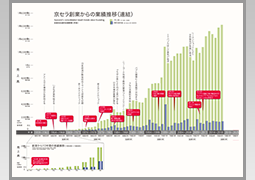
KDDI Corporation
With the deregulation of telecommunications in 1984, private enterprise could finally enter the communications business. Inamori established Daini-Denden Planning, a communications company that was the forerunner of Daini-Denden Company (DDI). Inamori expanded into providing dedicated long-distance service, long-distance service, and mobile phone businesses operated by various cellular services companies. He developed DDI into a major domestic communications enterprise that became the largest of the three new communications companies formed after deregulation. In 2000, Inamori led the way toward establishing KDDI Corporation from the merger of the three companies: DDI, Kokusai Denshin Denwa (KDD), and Nihon Idou Tsushin (IDO).
1984~1987
Inamori asked himself, "Is my motive virtuous or selfish?" before entering telecommunications business
Inamori had long felt that telephone charges in Japan were high and imposed a burden on people's lives. In 1984, when the decision was made to deregulate telecommunications, Inamori hoped that private enterprises would move into the sector and reduce long-distance telephone charges for the people's benefit.
However, standing up to the monolithic NTT carried enormous risks, and hardly any enterprises entered the market. Because of these circumstances, Inamori began thinking about entering communications as a venture business. His philosophy was to be of use to society and people through corporate management, so he contemplated the new venture from that perspective.
Before entering the telecommunications business, Inamori repeatedly examined his own intentions. He wanted to be sure that his motive was purely to lower telephone charges to benefit the people, rather than being even slightly for his own self-interest. For nearly six months, he asked himself, "Is my motive virtuous or selfish?" Finally, he was convinced that his motive was pure, without any self-interest driving him. He then set out with invincible determination to establish Daini-Denden (DDI) and to see the project through any difficulties that may emerge, for the benefit of the people.
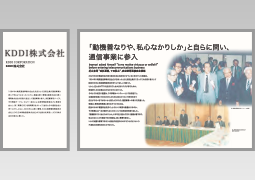
Succeeded in outpacing competitors with long-distance call service
As a new provider of dedicated line service for corporations and other organizations, DDI lacked significant backers such as large shareholders, big corporations or government authorities. DDI was therefore obligated to deal with market challenges on its own.
Thinking he would not be able to move the business forward under the circumstances, Inamori returned to his original reason for starting the company: "To stimulate fair competition in telecommunications and lower telephone charges for the people." Taking advantage of starting long-distance telephone services, he promptly shifted the company's emphasis from the original focus on dedicated line service to long-distance telephone services for the public.
Stepping ahead of his two competitors, he created a marketing team focused exclusively on long-distance telephone services, filled it with talented personnel, and actively engaged in sales promotion. As a result, by the time long-distance telephone services began in September 1987, DDI had signed up an overwhelming 450,000 subscribers, compared with 270,000 and 150,000, respectively, by its two competitors. With this success, DDI was firmly on the road to growth, positioned at the top of the new telecommunications companies.
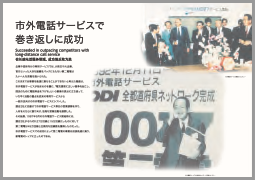
1987~1992
Entered mobile telecommunications business, anticipating coming age of mobile phones
In the 1980s, car phones comprised the majority of mobile phones. Constraints set out in Japan Radio Law meant that NTT continued to enjoy a monopoly. At the time, advances in miniaturization technology for semiconductors and other components indicated that the miniaturization of mobile phones was not far off. Inamori anticipated the arrival of an era in which people would be walking around carrying mobile phones in their daily lives. When Inamori established DDI, he already had a keen interest in mobile communications.
When mobile communications were deregulated in August 1986, he immediately declared that Kyocera would enter the business. Inamori had set his sights not on the car phones popular at the time, but on today's mobile phones that any person could walk around carrying. However, due to constraints on available frequencies under Radio Law, each service area could only have two mobile carriers -- and that included NTT. Carrier availability in service areas thus had to be divided between two companies, Nihon Kosoku Tsushin and DDI.
This configuration resulted in all kinds of difficulties that affected the fate of the entire business, effectively preventing a smooth rollout of services. Realizing that failure to align these services areas would ultimately hurt the people, Inamori relinquished both the Tokyo metropolitan and Chubu Tokai regions ― where most usage was expected ― to Nihon Kosoku Tsushin. DDI would take all of the other service areas, and a settlement was reached. For Inamori, it was a reluctant compromise. Even so, while it was unavoidable in order to start the mobile communications business as soon as possible to benefit the public, Inamori accepted it as "a defeat that was also a win."
Inamori knew that the success of the mobile phone business depended on services being firmly established in the different regions. He therefore set up a cellular business company in each region, solicited funding from power companies and other well-established regional enterprises, and called for their participation in the business. His strategy succeeded, and cellular business began to grow steadily.
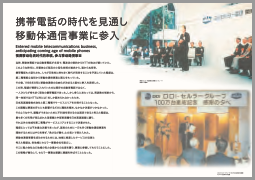
1993~1997
First among three new common carriers to be listed on the stock exchange
On September 3, 1993, DDI took the lead among the three new telephone companies and achieved listing on the second section of the Tokyo Stock Exchange. Listing took place just nine years after the preceding planning company, Daini-Denden Planning was established, and eight years after the planning company began operations. Market expectations were high, and the opening price reached 5.5 million yen, well above the public offer price of 3.7 million yen. Stock exchange listing improved DDI's ability to raise funds and heightened public awareness of the business. For employees, exchange listing increased their pride in the company and their levels of motivation, encouraging them to work hard for the business.
In November 1987, before DDI was listed, Inamori provided an opportunity for all employees who wished to do so to buy shares in the company. He hoped to raise awareness of individual employees as "managers," and to repay the efforts they had made since the company was founded. Inamori himself held no shares in the company, as he had entered the business with the pure and selfless motive of lowering telephone charges in Japan.
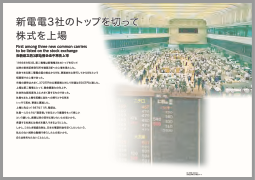
1998~the present
To benefit the public, ignore minor differences of opinion for the sake of greater common interests; Birth of KDDI
Although the communications business had been deregulated, in 1999, the NTT group still dominated the market. Knowing this, Inamori had already concluded that true communications deregulation was not possible within the current structure of three new telephone companies individually competing against the giant NTT. He became convinced that a firm axis of opposition to NTT was essential for the healthy development of Japan's communications industry, and began looking for opportunities to integrate with other communications companies. In due course, discussions about a merger with the international telephone business KDD and the mobile phone business IDO came to the fore. However, negotiations on mergers were extremely complicated, because they exposed differences in opinion and philosophies among the various companies.
In the face of repeated setbacks, Inamori stood by his conviction that "Japan cannot achieve true communications deregulation unless the three companies stand together in opposition to NTT." Based on the high ideal, "Discard minor differences and focus on the common good for the benefit of the public," Inamori led the three companies into a merger, all the while tenaciously espousing the importance of communications deregulation and the roles the three companies must play in achieving that goal.
The outcome was not a consolidation on an equal basis, but a merger of the three companies centered on DDI. This path was taken to accelerate decision-making and define management responsibilities, and to clarify the management core. It was an important factor behind the later advancement of KDDI.
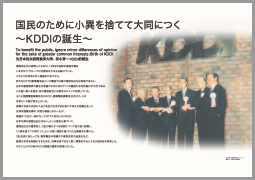
Japan Airlines Co., Ltd
Japan Airlines (JAL) began after the Second World War as a statutory company charged with responsibility for Japan's air industry. Operating under semi-governmental control, JAL served for many years as the nation's flagship carrier. However, following the collapse of Japan's economic bubble in 1991, business performance slumped due to falling demand. In January 2010, JAL applied for corporate bankruptcy reorganization. After repeated requests from the government of Japan to oversee the company's turnaround, Inamori finally accepted. Taking on the post of chairman, Inamori led a thorough transformation of every employee's managerial awareness, from management executives to hourly workers. By introducing Amoeba Management, he also improved employee profit awareness. Consequently, he revitalized the company in a short time and turned JAL into an airline with high profitability.
Took on task of reconstructing JAL
The fiscal structure of Japan Airlines had continued to deteriorate due to a prolonged period of stagnant business performance. The Japanese government realized that drastic reformation of the airline was essential to maintain Japan's airline network amid increasing international airline competition. The government, therefore, decided to apply Corporate Bankruptcy Reorganization Law and rebuild the company. Inamori was the business manager entrusted with resurrecting the company. Firmly refusing the government's request repeatedly on the grounds that it was not his place to rebuild JAL, he finally consented and accepted the post of JAL chairman. Inamori's decision to accept was based on three just reasons:
1. JAL's decline symbolized the decline of Japan's economy. Resurrecting the airline would restore people's confidence in Japan's economy.
2. Someone needed to rescue the remaining JAL employees and safeguard their employment.
3. Resurrecting JAL would stimulate market competition, enabling the airline to offer people less expensive quality service.
After assuming the post of chairman and undertaking business reconstruction, Inamori declined any salary or payment in kind on the grounds of his age (he was 78) and because he had other business commitments that prevented him from concentrating full-time on the work.
At the time, the mass media repeatedly stated that resurrecting JAL would be impossible, and a second bankruptcy was inevitable. They cited reasons including a corporate structure that had been dependent on government assistance for many years, complex union problems, the need for a broad business contraction, and fatal damage to JAL's brand image.
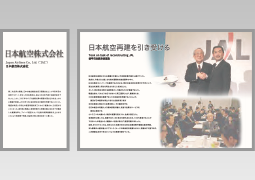
Actions to change employee mentality
Inamori strongly felt that the cause of bankruptcy was a lack of leadership awareness among senior management. Convinced that resurrecting JAL would be impossible without reforming their awareness, he began with executive employees.
In June of 2010, he gathered about 50 executives and conducted intensive retraining over 17 sessions on the theme, "What is the right thing to do as human beings, and as leaders of organizations?" Meanwhile, he visited main airports including Narita and Haneda, where he explained the proper attitude toward work directly to employees in their workplaces, including those who worked in sales, reservations, maintenance, cabin crews and ground crews, among others. At first, some executives and general employees felt uncomfortable being lectured on the topic, and initially, there was a certain level of resistance. However, as Inamori continued to speak with absolute sincerity, a significant change emerged in employee attitudes.
Additionally, he created the JAL Philosophy, which set the standard for employee's decisions and actions. As a result of his efforts to build shared awareness among all employees, Inamori improved the customer service mentality and attained unity in cooperation that transcended individual departments. Japan Airlines saw the birth of an approach in which individual employees took the initiative in thinking about company concerns and acted accordingly.
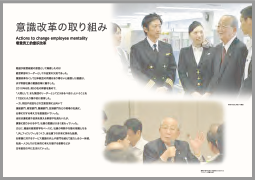
Actions to improve profitability
When Inamori took the post of chairman, he discovered that Japan Airlines had only minimal awareness of profitability. It seemed that almost no executives or employees had any interest in the management figures. So, he took the following steps. By applying the Amoeba Management system, he created a way to attain prompt statistics on the revenue and expenditures for individual flight routes, as well as for individual aircraft. Such timely information empowered employees to take specific actions that could improve the results. He gave individuals responsibility for specific flight routes. Those people then took the leading role in devising and applying measures for raising the profitability of their specific flight routes.
Based on Amoeba Management, Inamori thus built a management accounting system designed specifically for Japan Airlines. The system provided detailed management figures for individual departments with minimal delay. Furthermore, he established monthly Management Review Meetings in which leaders of the various JAL departments and affiliated companies presented management results for their respective departments.
Giving individual department leaders the ability to pinpoint operational problems and then implement improvement measures led to increased profitability in each department. At the same time, employees gained a higher awareness of costs. All employees thus began to take the initiative in working toward improving profit, which contributed significantly to overall profitability.
The management philosophy that unified employees was known as the JAL Philosophy. Measures to reform the awareness and attitudes of employees were based on this philosophy. At the same time, the introduction of Amoeba Management and the resulting rise in profitability led to rapid improvements in the company's business performance and financial structure.
JAL was reborn as the airline with the highest profitability among all major airlines worldwide. On September 19, 2012, Japan Airlines was relisted on the stock exchange. Just two years and seven months after delisting, this short turnaround was unprecedented in Japan's history.
The graph to the right illustrates JAL's business results before and after Inamori became chairman. Before his appointment, sales were 1.5 trillion yen with a substantial operating deficit of negative 133.7 billion yen. The following year, sales fell slightly to 1.3622 trillion yen, but operating profit achieved a V-shaped recovery to 188.4 billion yen. In the year after that, sales were 1.2048 trillion yen, but operating profit had increased to 204.9 billion yen, with a profit ratio of 17 percent. Japan Airlines was resurrected into a high-profit airline.

Amoeba Management/Kyocera Accounting Principles
Amoeba Management
Amoeba Management is a unique management control system that Inamori created to support his management philosophy while leading Kyocera. Under Amoeba Management, an organization is divided into small business units (Amoebas). Each Amoeba is run as an independent, market-oriented profit center. This management system fosters leadership development by diffusing managerial awareness throughout the work force, and allowing all employees to participate in management -- known as "Management by All."
The Philosophy is essential for Amoeba Management
Amoeba Management is not a style of management expertise that is exalted by the business world in general. The methods of the Amoeba Management system may be copied or emulated, but in many instances, it does not function effectively. That's because Amoeba Management is a "total management control system" based on a management philosophy, and in which all systems involved in company operations are deeply intertwined.
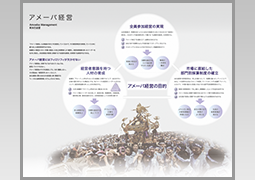
Develop leaders with managerial awareness
By dividing an organization into smaller organizations called Amoebas, the company, in effect, becomes an alliance of small and medium-sized enterprises. Entrusting the management of individual Amoeba units to leaders cultivates human resources with managerial awareness.
1. For this purpose, a large organization is divided into smaller units called Amoebas.
2. A leader is appointed within each Amoeba. The overall management of an Amoeba is entrusted to its leader, who oversees business planning, management of results, labor management and materials purchases. This system leads employees to develop managerial awareness.
↓
- Creates an organizational climate that encourages individual challenge
- Builds a culture of achieving goals
- Leads to timely and accurate management decisions
Establish a market-oriented unit divisional accounting system
The fundamental principle of business management is to maximize revenues and minimize expenses. Inamori applied this principle to the entire company by dividing it into small units, called Amoebas. Each Amoeba is managed as an independent profit center that can respond promptly to market changes.
1. Each Amoeba pursues profit by practicing the principle of "Maximize Revenues and Minimize Expenses."
2. Each Amoeba is an independent accounting unit that can buy and sell with other Amoebas.
3. Each Amoeba prepares Hourly Efficiency reports, which all employees can read as easily as a household budget.
↓
- Identifies business issues down to the smallest Amoeba level
- Provides visibility to all aspects of the company's operations
- Enhances employee awareness of profit and loss
Practice "Management by All"
All employees combine their strengths to move company development forward. Implementing the practice of "Management by All" enables employees to participate in management, and thereby work with motivation and a sense of accomplishment.
1. Each Amoeba unit's members participate in preparing plans and work together to attain shared goals.
2. Each Amoeba creates a fiscal-year plan, known as the Master Plan, based on the direction and goals of the entire company.
3. Each Amoeba creates monthly plans based on the Master Plan and manages according to results.
↓
- Consolidates collective wisdom of the workplace
- Achieving goals creates a sense of accomplishment and purpose
- Cultivates a sense of unity in the workplace
Kyocera Accounting Principles
When he founded Kyocera, Inamori, who was trained as an engineer, had no detailed knowledge of management or accounting. As soon as the company began operating, Inamori was called on to make decisions about all manner of management-related issues. After spending considerable time debating within himself on what criteria should be used for reaching decisions, Inamori decided to base his decision-making on "What is right as a human being."
He applied this also in the field of accounting. Whatever problems might emerge in accounting, Inamori determined that he would always return to the essence of the matter and look for solutions based on "What is right." This approach led to the creation of "Kyocera Accounting Principles," a system based on fundamental principles of accounting rather than adherence to commonly accepted accounting practices.
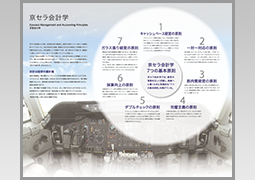
Accounting is management's compass
Accounting figures are like the instrument dials of an aircraft cockpit. A pilot flies a plane by looking at the instruments to judge altitude, speed and bearing. In a similar manner, successful managers look at accounting figures to judge the state of their enterprise and navigate the way forward.
If an aircraft's instruments are wrong, the pilot will not be able to fly the plane correctly. In the same way, if accounting figures are inaccurate, then the company will be likely -- at the very least -- to fly in the wrong direction.
In other words, accounting figures act as a compass for the company's managers. The compass is pivotal to the company's progress, and this is why accounting is so important.
The Seven Principles of Kyocera Accounting
The Kyocera Accounting Principles contain seven basic practical concepts that allow managers to accurately assess the current state of the company and enable them to lead the company to prosperity.
1 The Principle of Cash-Basis Management
The Principle of Cash-Basis Management describes a simple management style that focuses on the flow of cash. Modern-day accounting has become so complex that it is difficult to see the actual condition of a company. Returning to the original intent of accounting, which is to convey the state of business accurately, we should make management decisions focused on the most crucial aspect: cash flow.
2 The Principle of One-to-One Correspondence
In the daily course of business, both cash and goods flow constantly. Any movement of cash or goods must be accompanied by the correct documentation. We call this the Principle of One-to-One Correspondence. Strictly following this principle allows the accumulation of daily invoices to correspond accurately with the corporate financial totals. This, in turn, will reflect the true financial status of the corporation.
3 The Principle of Muscular Management
If we were to compare a corporation to the human body, the company should strive to maintain a lean, athletic physique with no excess weight. We call this Muscular Management. This principle is the backbone of Kyocera's accounting.
4 The Principle of Perfectionism
The fourth principle is Perfectionism, and refers to the basic posture of management that aims for perfection in every detail of the business, without any ambiguity or compromise. Especially in accounting, 100% accuracy is required.
5 The Principle of Double-Check
The Principle of Double-Check is a mechanism that helps prevent people from committing fraud and sustains the company's integrity beyond accounting to many other aspects of business. Receivables and payables must be cross-checked by different people. This double-check system maintains the integrity of our work and the soundness of the organization.
6 The Principle of Profitability Improvement
The most important mission of corporate accounting is to improve profitability. By adopting the individual small profit center system called Amoeba Management, Kyocera enables all employees to contribute to improving profitability.
7 The Principle of Transparent Management
It is essential to disclose the actual condition of the company openly to employees in order to build strong trust between management and employees. That's why Kyocera practices transparent management and shares the company's true financial condition, not only with top executives but also with all employees.
Furthermore, it is also vital that the company fairly discloses such information to the public. Accurate information on the company's condition must be made available to concerned outside parties, such as shareholders or investors.